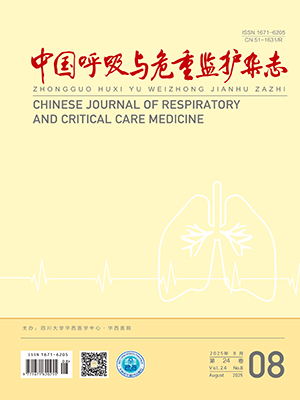| 1. |
McCormack FX, Travis WD, Colby TV, et al. Lymphangioleiomyomatosis: calling it what it is: a low-grade, destructive, metastasizing neoplasm. Am J Respir Crit Care Med, 2012, 186(12): 1210-1212.
|
| 2. |
McCormack FX, Gupta N, Finlay GR, et al. Official American Thoracic Society/Japanese Respiratory Society Clinical Practice Guidelines: lymphangioleiomyomatosis diagnosis and management. Am J Respir Crit Care Med, 2016, 194(6): 748-761.
|
| 3. |
Steagall WK, Pacheco-Rodriguez G, Darling TN, et al. The lymphangioleiomyomatosis lung cell and its human cell models. Am J Respir Cell Mol Biol, 2018, 58(6): 678-683.
|
| 4. |
Lam HC, Nijmeh JS, Henske EP. New developments in the genetics and pathogenesis of tumours in tuberous sclerosis complex. J Pathol, 2016, 241(2): 219-225.
|
| 5. |
Taveira-DaSilva AM, Moss J. Clinical features, epidemiology, and therapy of lymphangioleiomyomatosis. Clin Epidemiol, 2015, 7: 249-257.
|
| 6. |
McCormack FX. Lymphangioleiomyomatosis: a clinical update. Chest, 2008, 133(2): 507-516.
|
| 7. |
Ryu JH, Moss J, Beck GJ, et al. The NHLBI lymphangioleiomyomatosis registry: characteristics of 230 patients at enrollment. Am J Respir Crit Care Med, 2006, 173(1): 105-111.
|
| 8. |
Johnson SR, Cordier JF, Lazor R, et al. European Respiratory Society guidelines for the diagnosis and management of lymphangioleiomyomatosis. Eur Respir J, 2010, 35(1): 14-26.
|
| 9. |
Young L, Lee HS, Inoue Y, et al. Serum VEGF-D a concentration as a biomarker of lymphangioleiomyomatosis severity and treatment response: a prospective analysis of the Multicenter International Lymphangioleiomyomatosis Efficacy of Sirolimus (MILES) trial. Lancet Respir Med, 2013, 1(6): 445-452.
|
| 10. |
Young LR, Vandyke R, Gulleman PM, et al. Serum vascular endothelial growth factor-D prospectively distinguishes lymphangioleiomyomatosis from other diseases. Chest, 2010, 138(3): 674-681.
|
| 11. |
Gupta N, Finlay GA, Kotloff RM, et al. Lymphangioleiomyomatosis diagnosis and management: high-resolution chest computed tomography, transbronchial lung biopsy, and pleural disease management. An Official American Thoracic Society/Japanese Respiratory Society Clinical Practice Guideline. Am J Respir Crit Care Med, 2017, 196(10): 1337-1348.
|
| 12. |
McCormack FX, Inoue Y, Moss J, et al. Efficacy and safety of sirolimus in lymphangioleiomyomatosis. N Engl J Med, 2011, 364(17): 1595-1606.
|
| 13. |
Gao N, Zhang T, Ji J, et al. The efficacy and adverse events of mTOR inhibitors in lymphangioleiomyomatosis: systematic review and meta-analysis. Orphanet J Rare Dis, 2018, 13(1): 134.
|
| 14. |
Taveira-DaSilva AM, Jones AM, Julien-Williams P, et al. Long-term effect of sirolimus on serum vascular endothelial growth factor D levels in patients with lymphangioleiomyomatosis. Chest, 2018, 153(1): 124-132.
|
| 15. |
Peng ZF, Yang L, Wang TT, et al. Efficacy and safety of sirolimus for renal angiomyolipoma in patients with tuberous sclerosis complex or sporadic lymphangioleiomyomatosis: a systematic review. J Urol, 2014, 192(5): 1424-1430.
|
| 16. |
Wataya-Kaneda M, Ohno Y, Fujita Y, et al. Sirolimus gel treatment vs placebo for facial angiofibromas in patients with tuberous sclerosis complex: a randomized clinical trial. JAMA Dermatol, 2018, 154(7): 781-788.
|
| 17. |
Darling TN. Topical sirolimus to treat tuberous sclerosis complex (TSC). JAMA Dermatology, 2018, 154(7): 761-762.
|
| 18. |
Bee J, Fuller S, Miller S, et al. Lung function response and side effects to rapamycin for lymphangioleiomyomatosis: a prospective national cohort study. Thorax, 2018, 73(4): 369-375.
|
| 19. |
Xu KF, Tian X, Yang Y, et al. Rapamycin for lymphangioleiomyomatosis: optimal timing and optimal dosage. Thorax, 2018, 73(4): 308-310.
|




